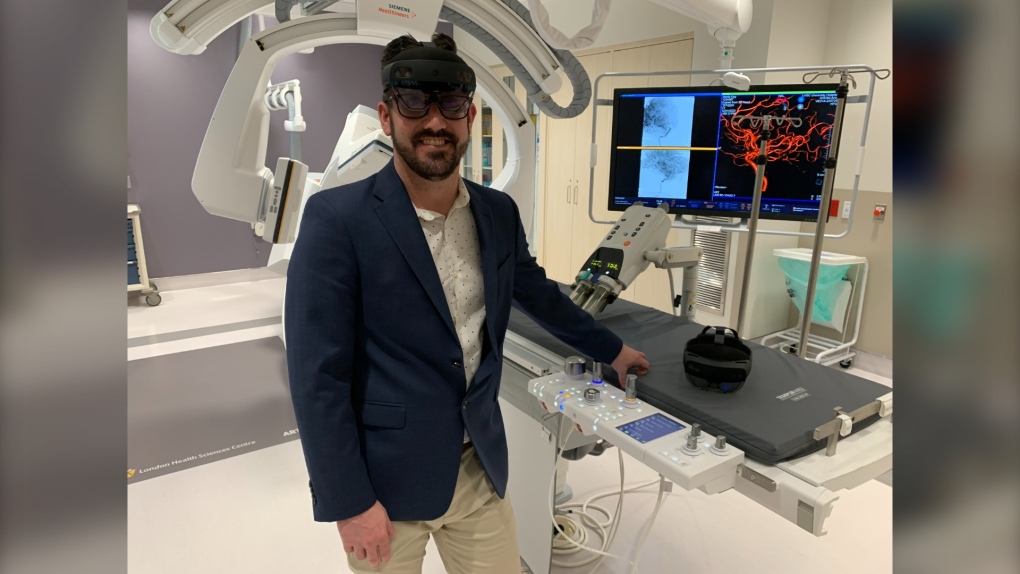'Like you’ve stepped a little bit into the future': Mixed reality technology being used to treat patients at LHSC
A new mixed reality research project is taking x-rays to a whole new level at London Health Sciences Centre.
“The HoloLens technology allows those virtual screens to be placed wherever the physician wants. Kind of maintains the contact between the physician and the patient,” explained Jonathan Collier, an interventional radiology technologist.
Wearing a special mixed reality headset, Collier looks at and manipulates a volume rendered virtual model, or hologram, of an anatomized brain aneurysm. He can manipulate the hologram and move it into place exactly where he wants, allowing him to perform a minimally invasive procedure with great accuracy.
The best part for the operating physician, is that they no longer have to look at a traditional monitor off to the side or in another part of the room.
Division Lead for Diagnostic and Interventional Neuroradiology at LHSC Dr. Sachin Pandey was among the first to use the Microsoft HoloLens.
He said patients are duly impressed.
“Oh well you can imagine, there is a certain kind of wow factor to it right, you feel like you’ve stepped a little bit into the future,” he explained.
 Interventional radiology technologist Jonathan Collier wears a mixed reality headset in London, Ont. on March 7, 2024. (Bryan Bicknell/CTV News London)
Interventional radiology technologist Jonathan Collier wears a mixed reality headset in London, Ont. on March 7, 2024. (Bryan Bicknell/CTV News London)
“The benefit of the patient, in theory, is they get the undivided attention physically and mentally of their doctor. In fact, that talking and being responsive to the patient is a big part of what makes it a tolerable experience for people. So again. Any barrier you can remove from the patient helps do that,” he added.
The software for HoloLens was developed by Dr. David Hocking, a diagnostic and interventional radiologist at LHSC. He said he saw a way to achieve better patient outcomes.
“The closer you can bring your visual field to where you’re working, the better your accuracy. And this allows us to put the screen front and centre with the patient,” he said.
The mixed reality research project is supported by more than $1 million in funding from the London Health Sciences Foundation and the Children’s Health Foundation.
“This is a pilot project so we are right at the baby steps of where I think this can be generalized,” said Pandey.
CTVNews.ca Top Stories

Calgary woman stranded in Mexico after husband's death during diving trip
A Calgary woman is struggling to return home after her husband died while diving in Mexico, leaving her stranded and facing financial hardship.
Fugitive U.S. rioter seeks asylum in Whistler amid warnings of more to come
An American citizen convicted of participating in the Jan. 6, 2021, riot on Capitol Hill and dodging jail time in Whistler may just be the start of an asylum-seeking rush, according to a prominent legal expert.
Special national Liberal caucus meeting called for next week after regional chairs meet: sources
A special meeting of Prime Minister Justin Trudeau's national Liberal caucus has been called for next Wednesday, sources say.
N.S. community shocked by deaths of father, daughter; suspect was wanted in Toronto shooting
A Nova Scotia community is mourning the loss of two of its members after they were shot and killed in Halifax on New Year's Eve.
Canada pausing applications for parent, grandparent permanent residency sponsorships
Canada will not accept new parent and grandparent permanent residency sponsorship applications until further notice, according to a ministerial directive.
Soldier who blew up Tesla at Trump hotel left note saying blast was to be a 'wakeup call' for the U.S.
A highly decorated Army soldier who fatally shot himself in a Tesla Cybertruck just before it blew up outside the Trump hotel in Las Vegas left notes saying the New Year's Day explosion was a stunt to serve as a “wakeup call” for the country’s ills, investigators said Friday.
Sea and Himalayan salts recalled in Canada: 'Do not use, serve or distribute'
Two brands of sea and Himalayan salt are being recalled in Canada due to pieces of plastic found in the products.
'Inadmissible' foreign nationals to pay more upon return to Canada: CBSA
Foreign nationals who refuse or are unable to pay their own way home after being denied stay in Canada will soon face steeper financial penalties should they ever attempt to return.
'It's about time': Experts in Canada support call for warnings about cancer risk from alcohol
While Canada hasn't mandated cancer warnings for alcoholic beverages, a few experts are supporting a new push in the U.S. to have the labels on the products.

































